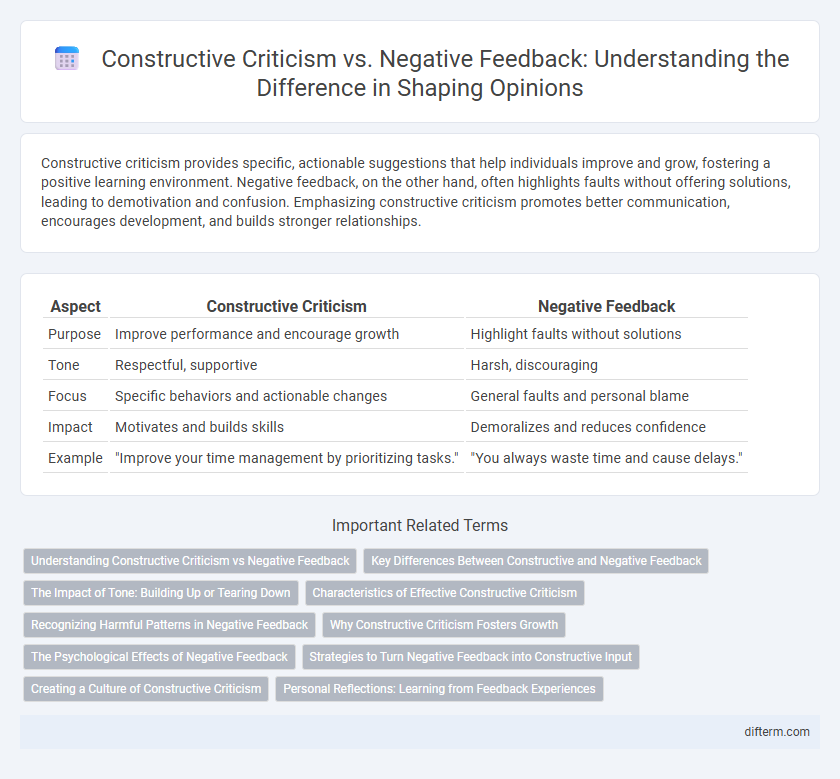Constructive criticism provides specific, actionable suggestions that help individuals improve and grow, fostering a positive learning environment. Negative feedback, on the other hand, often highlights faults without offering solutions, leading to demotivation and confusion. Emphasizing constructive criticism promotes better communication, encourages development, and builds stronger relationships.
Table of Comparison
| Aspect | Constructive Criticism | Negative Feedback |
|---|---|---|
| Purpose | Improve performance and encourage growth | Highlight faults without solutions |
| Tone | Respectful, supportive | Harsh, discouraging |
| Focus | Specific behaviors and actionable changes | General faults and personal blame |
| Impact | Motivates and builds skills | Demoralizes and reduces confidence |
| Example | "Improve your time management by prioritizing tasks." | "You always waste time and cause delays." |
Understanding Constructive Criticism vs Negative Feedback
Understanding constructive criticism involves recognizing feedback aimed at fostering growth and improvement through specific, actionable suggestions. Negative feedback, by contrast, often highlights faults without offering solutions, which can decrease motivation and hinder development. Emphasizing clarity, empathy, and purpose in criticism ensures effective communication and promotes a positive change.
Key Differences Between Constructive and Negative Feedback
Constructive criticism centers on specific, actionable suggestions aimed at improvement, fostering growth and motivation, whereas negative feedback often highlights faults without guidance, leading to defensiveness or decreased morale. The tone of constructive feedback remains supportive and balanced, focusing on behaviors rather than personal attributes, while negative feedback tends to be vague and personal, triggering emotional reactions. Emphasizing solution-oriented dialogue, constructive criticism encourages ongoing development, contrasting sharply with the often demoralizing and unproductive nature of negative feedback.
The Impact of Tone: Building Up or Tearing Down
Tone plays a crucial role in shaping the impact of feedback, where constructive criticism fosters growth by highlighting specific areas for improvement with empathy and clarity. Negative feedback, often delivered harshly or vaguely, can demoralize individuals, leading to decreased motivation and productivity. Understanding how tone influences emotional response helps transform feedback into a powerful tool for development rather than a source of discouragement.
Characteristics of Effective Constructive Criticism
Effective constructive criticism is specific, actionable, and focused on behavior rather than personal traits, enabling recipients to understand the issue clearly and implement improvements. It maintains a respectful and supportive tone, fostering a growth mindset and encouraging open communication. Timeliness and balance, combining positive reinforcement with areas for improvement, enhance receptivity and motivate continuous development.
Recognizing Harmful Patterns in Negative Feedback
Recognizing harmful patterns in negative feedback is essential to foster personal and professional growth without causing emotional distress. Constructive criticism focuses on specific behaviors and offers actionable solutions, while negative feedback often relies on vague, generalized, or overly harsh language that erodes self-esteem. Distinguishing between these approaches ensures that feedback serves as a tool for improvement rather than a source of harm or demotivation.
Why Constructive Criticism Fosters Growth
Constructive criticism fosters growth by providing specific, actionable insights that help individuals identify areas for improvement and develop new skills. Unlike negative feedback, which often emphasizes faults without solutions, constructive criticism encourages a growth mindset and motivates positive change. Research shows that employees who receive constructive feedback are more engaged and perform better, leading to long-term professional development.
The Psychological Effects of Negative Feedback
Negative feedback often triggers stress responses in the brain, leading to decreased motivation and increased anxiety, which can hinder performance and creativity. In contrast, constructive criticism, when delivered thoughtfully, promotes a growth mindset by focusing on specific improvements and fostering resilience. Understanding the psychological effects of negative feedback is crucial for developing effective communication strategies that enhance learning and emotional well-being.
Strategies to Turn Negative Feedback into Constructive Input
Transforming negative feedback into constructive input involves active listening to understand the core issues and asking clarifying questions to uncover actionable points. Adopting a growth mindset encourages viewing criticism as an opportunity for development rather than a personal attack. Implementing specific, measurable goals based on feedback helps convert vague complaints into targeted improvement strategies.
Creating a Culture of Constructive Criticism
Creating a culture of constructive criticism fosters continuous improvement by emphasizing actionable insights and respectful communication, which motivates employees to engage and innovate. Constructive criticism builds trust and strengthens team dynamics by focusing on behavior and results rather than personal attributes. Shifting from negative feedback to constructive dialogue enhances organizational learning and drives sustainable performance growth.
Personal Reflections: Learning from Feedback Experiences
Constructive criticism fosters personal growth by highlighting specific areas for improvement while maintaining respect, making it easier to accept and apply feedback effectively. Negative feedback often lacks actionable suggestions and can diminish motivation, causing resistance rather than progress. Reflecting on past experiences reveals that embracing constructive criticism enhances self-awareness and skill development more than reacting defensively to negative comments.
constructive criticism vs negative feedback Infographic

 difterm.com
difterm.com